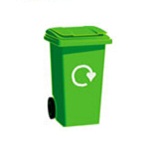Below we have some great information about recycling - all taken from those knowledgeable people at Recycle Now. You can learn more at their own website. We'll be adding more here shortly.

What Happens to our Recycling?
Recyclable items are predominantly collected from your home in two ways:
There are kerbside ‘sort’ schemes where recyclables are sorted into their respective materials on the lorry at the kerbside; and co-mingled collections where all your recyclables are put into one compartment on the lorry before being taken to a Materials Recovery Facility (MRF) and sorted.
At the MRF, all the mixed recycling is sorted and separated into different types of materials by hand or machine (or both) before being sent to manufacturers who make it into new products.
Once collected and sorted, recycled materials become valuable commodities in the worldwide market.
There are many recycling plants here, reprocessing million of tonnes of material every year. For example:
- all of the newsprint manufactured here in the UK is now made from 100% recycled paper
- all of the organic (garden and kitchen) waste we collect is recycled here, usually quite close to where it is collected
- over 80% of the glass collected for recycling is used in the UK, the majority of it to make new glass bottles and jars
There is an ever increasing range of high quality products that are made in the UK from recycled materials. To find out what your recyclables are being made into click on the respective materials fact files page.
Countries such as China are prepared to pay high prices for recyclables such as waste plastic; mainly because they do not have readily available sources of virgin materials (no indigenous forests or oil supplies) and they have a large manufacturing industry that requires these products.
Even though exporting our recyclables means a bigger recycling loop because recyclable materials are transported further, it is still a better environmental option than using virgin, raw materials because:
- it minimises the need to use our natural resources such as oil
- using recycled materials significantly reduces energy use and carbon emissions during the manufacturing process;
- the transport impacts are reduced because the materials are transported in container ships returning to China after bringing the goods to the UK
- it means those materials are not being landfilled
Facts & Figures:
Information collected for Defra by the Environment Agency on packaging waste shows how much material is exported and how much is recycled in the UK:
Material - Reprocessed in the UK - Reprocessed Abroad:
Paper 49% - 51%
Glass - 81% - 19%
Aluminium - 66% - 34%
Plastic - 33% - 67%
Wood - 100% - 0%
The CPI figures, which include newsprint, indicate a balance of about 47% domestic reprocessing and 53% export.
Everything goes to Landfill, doesn't it?
Well, actually, NO.
In the UK more than 95% of the recycling collected is recycled. The remaining 5% is often not recycled because the wrong materials have been put out for collection or are too dirty to be reprocessed. The recycled material is used to make new products:
- All the newsprint (the paper for newspapers) manufactured in the UK is now made from 100% recycled
- The UK currently recycles around 50% of container glass (like bottles and jars). That’s doubled over the last 5 years
- Any glass product can use up to 80% recycled material
- It takes about 25 2-litre drinks bottles to make one adult size fleece jacket
As well as the environmental benefits of recycling, there are financial incentives too – a growing number of companies such as those featured on www.recycledproducts.org.uk rely on recycled materials for their products and services. If everything really went to landfill, these companies wouldn’t exist!
So where does waste go?
It depends on the material and the way it is collected from your house. If it is not sorted into separate materials by your refuse collectors, your recycling will go to a materials recycling facility to be sorted. The sorted materials are sold to reprocessing companies who turn them back into raw materials; these are then used to make new products. Here's a peek into the world of waste recycling:
Aluminium cans are shredded, melted down, and the molten aluminium poured into moulds to make ingots. These are then sold to companies who make new products such as car and plane parts, or maybe the can containing your next drink!
Glass is crushed and added to the mix of raw materials that make up new glass containers. - The materials are melted in a furnace, and then moulded or blown to make new bottles and jars. Glass is also used to make unusual stuff - it's an ingredient used to make new bricks and a filtration media for swimming pools.
Sorted plastics have a wide variety of uses and can be shredded, washed, melted and moulded into new products such as new bottles, garden furniture or fleece jackets.
When paper gets to the recycled paper mill it is added to water and turned into pulp. It is screened, cleaned and where required, de-inked until it is suitable for making new paper products such as newsprint, cardboard, packaging, tissue and office items. It can take just seven days for a newspaper to go through the recycling process and be transformed into recycled newsprint which is used to make the majority of Britain's national daily newspapers.
Steel is a brilliant product to recycle, as it can be reprocessed again and again. Steel cans are melted down in a furnace and combined with other raw materials like molten iron. The hot steel is then cast into solid slabs which can be rolled into foil to make new cans.
